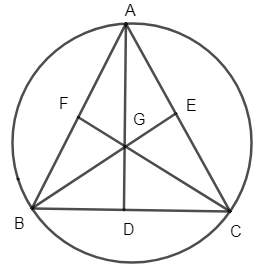
Show that in an equilateral triangle, circumcentre, orthocenter and incenter overlap each other.
Answer
527.1k+ views
Hint: Draw a rough figure, the median will be perpendicular to the base. Thus draw medians from all vertices and find the centroid G. By using the property of equilateral triangle centroid is equidistant from the center.
Complete step-by-step answer:
Consider the figure that is drawn below. From the figure you can make out that ABC is the equilateral triangle.

Now let us consider G as the centroid of equilateral
Now from the figure, let us consider
As the
i.e. AB = BC = AC.
Similarly, in an equilateral triangle all the angles are the same.
i.e.
Thus in
BC = BC, this side is common for both triangles.
BF = CE, these sides are equal.
Thus we can say that
Thus
Similarly, we can prove that
From (1) and (2) we can say that,
AD = BE = CF.
If we are considering the centroid of the triangle, the centroid theorem states that the centroid of the triangle is at
Thus,
Similarly,
i.e. We can say that G is equidistant from the vertices.
Thus we can say that G is the circumcenter of
Hence we have proved that in the equilateral triangle the centroid and the circumcenter of the triangle coincide.
Note: In the case of an equilateral triangle to find the centroid we can use the centroid theorem. If the coordinates of a triangle is given, the centroid of the triangle can be found by using a formula. The 3 vertices are
Complete step-by-step answer:
Consider the figure that is drawn below. From the figure you can make out that ABC is the equilateral triangle.

Now let us consider G as the centroid of equilateral
Now from the figure, let us consider
As the
i.e. AB = BC = AC.
Similarly, in an equilateral triangle all the angles are the same.
i.e.
Thus in
BC = BC, this side is common for both triangles.
BF = CE, these sides are equal.
Thus we can say that
Thus
Similarly, we can prove that
From (1) and (2) we can say that,
AD = BE = CF.
If we are considering the centroid of the triangle, the centroid theorem states that the centroid of the triangle is at
Thus,
Similarly,
i.e. We can say that G is equidistant from the vertices.
Thus we can say that G is the circumcenter of
Hence we have proved that in the equilateral triangle the centroid and the circumcenter of the triangle coincide.
Note: In the case of an equilateral triangle to find the centroid we can use the centroid theorem. If the coordinates of a triangle is given, the centroid of the triangle can be found by using a formula. The 3 vertices are
Recently Updated Pages
Master Class 12 Economics: Engaging Questions & Answers for Success

Master Class 12 Maths: Engaging Questions & Answers for Success

Master Class 12 Biology: Engaging Questions & Answers for Success

Master Class 12 Physics: Engaging Questions & Answers for Success

Master Class 4 Maths: Engaging Questions & Answers for Success

Master Class 4 English: Engaging Questions & Answers for Success

Trending doubts
Fill the blanks with the suitable prepositions 1 The class 9 english CBSE

Difference Between Plant Cell and Animal Cell

Given that HCF 306 657 9 find the LCM 306 657 class 9 maths CBSE

The highest mountain peak in India is A Kanchenjunga class 9 social science CBSE

What is the difference between Atleast and Atmost in class 9 maths CBSE

What is pollution? How many types of pollution? Define it




